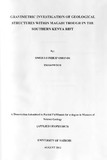| dc.description.abstract | Gravity method has been used for many years in the field of exploration like in oil
exploration, geothermal exploration and in mineral exploration. It is one of the cheapest
methods for data acquisition compared to other methods. In this study, gravity method was
applied in mapping the study area with the aim of delineating sub surface geological
structures, which are associated with hydrocarbon traps, their depth and location within the
study area.
Magadi trough is situated in the southern part of the Kenyan tertiary rift about 110 km south
of Nairobi, where it neighbours Tanzania to the south. It is occupied by broad half-graben
depression highly filled with sediments and tilted blocks of late Miocene to early Pliocene.
The complete Bouguer anomaly in mGal was obtained as secondary data from National Oil
Corporation of Kenya (NOCK). The data was gridded and maps were obtained using Oasis
Montaj from Geosoft Inc. These maps were used to interpret the subsurface anomalies. The
techniques which were used in Oasis Montaj to develop various maps are the analytical
signal, 3D Euler deconvolution, horizontal derivative, vertical derivative and upward
continuation.
From the interpretations, depocenters were mapped to the northern and southern part of
Complete Bouguer Anomaly Map figure 5.1. Determination of depth to basement of the study
area was done by use of 3D Euler deconvolution. The major structures mapped were faults
and dyke. The fault is trending in NE-SW direction. The highest recorded value of depth to
basement of the study area was about 8.1 km. The techniques applied revealed that the area
accommodates depocenters along a fault to the north, to the south and at the central part, with
an anticline to the west of the study area and a dyke to the south east. These revealed that area
is structurally controlled and was affected tectonically. The fault was evident in the long
stretch of the gravity low region which trends in the NE-SW. The sediment thickness in the
study area was found to range from about 2km to 7 km. The presence of these structures
shows that the area has a great potential of hydrocarbon traps. | en |

